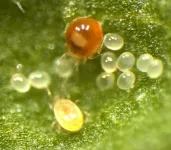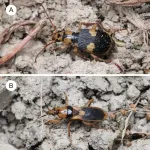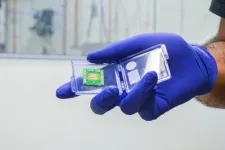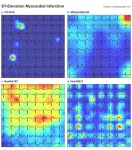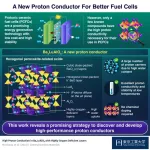(Press-News.org)
Several animal species display brood care, a phenomenon where ‘caring’ parents provide their offspring with food and protection against predators. However, there are many others that prefer not to do this, and instead sneak in their eggs with those of other ‘caring’ species to avail free brood care. This behavior, called brood parasitism, is observed in fishes, frogs, and birds, with the most famous example being that of the cuckoo. Such brood parasitism has now also been observed in the insect world in tiny organisms called mites. Generally, brood parasitism takes a toll on the host and benefits the parasite. However, in certain circumstances, it can turn out to be costly to the parasite, thereby resulting in optional or ‘facultative’ brood parasitism.
Diving deeper into this, Associate Prof. Yasuyuki Choh from Chiba University, Japan, and Arne Janssen from the University of Amsterdam and the Federal University of Viçosa shed more light on factors that drive facultative brood parasitism. “In our study, we tested whether brood parasitism in predatory mites is facultatively induced by the risk of egg predation. We studied two predatory mite species that share a food source and an egg predator,” elucidates Dr. Choh. Their study was published online in Functional Ecology on April 13, 2023.
For this study, the researchers chose Neoseiulus californicus (N. californicus) and Gynaeseius liturivorus (G. liturivorus), two predatory mite species that eat western flower thrips (Frankliniella occidentalis)—an insect that is an important plant pest in agriculture. While thrips mostly consume plant tissue and pollen, they can sometimes also prey on the eggs of the two predatory mites. This makes thrips not only prey but also egg predators of these mite species. Moreover, the adults of these two mite species also prey on each other’s younger stages. Whereas G. liturivorus is known to protect its eggs by attacking and feeding on egg predators, N. californicus shows no such brood care.
Thus, the researchers tried to understand the relationship of brood parasitism between N. californicus (parasite) and G. liturivorus (host) by assessing how it affected the host, the parasite, and their respective offspring. For doing that, they observed how the two mite species interacted in the presence and absence of 1) thrips (egg predator) and 2) two-spotted spider mites (alternate prey but not an egg predator).
The researchers found that the adult female parasite preferred to lay its eggs near the host eggs, even when the adult female host was absent. But this preference was only seen in the presence of the thrips. When the thrips were replaced with spider mites, another prey of the two predatory mites that do not attack their eggs, the parasite showed no significant inclination toward placing its eggs with host eggs, indicating that brood parasitism could be conditional to the risk of egg predation. Moreover, brood parasitism was not observed when the host eggs were replaced by eggs of another predatory mite, Phytoseiulus persimilis, which does not guard its eggs. This suggests that the parasite specifically prefers adding its eggs to guarded host eggs when egg predators are around to increase the parasite offspring’s chance of survival. But this has a heavy cost on the host in terms of a higher risk of predation of its eggs by the adult female parasite.
The researchers further noted that the risk of egg predation is reversed in the absence of egg predators. When the scientists removed the thrips from the site, the adult female host could no longer feed on thrips and started attacking and feeding on the parasite offspring, making brood parasitism disadvantageous for the parasite.
Explaining the implications of this work, Dr. Choh says, “The facultative nature of the brood parasitism may not only serve to reduce costs for the parasite in the absence of egg predators but may also prevent the evolution of host behavior to avoid brood parasitism, which would result in an evolutionary arms race between parasite and host.”
These findings emphasize the significance of risk associated with egg predation as a major driver for facultative brood parasitism and contribute to a better understanding of the evolution of such risk-dependent brood parasitism.
About Dr. Yasuyuki Choh
Dr. Yasuyuki Choh is an Associate Professor at the Graduate School of Horticulture, Chiba University, Japan. His research interests lie in the domain of predator-prey interactions among plants, herbivores, insects, and predators, as well as tritrophic interactions, insect behavior, intraguild predation, herbivore-induced plant volatiles, host-plant selection, and evolutionary ecology, among others. He has several publications to his credit, including the book “Herbivore-induced plant volatiles prime two indirect defenses in lima bean.”
END
Reporters and bloggers are invited to join top nutrition experts for a dynamic program at NUTRITION 2023. The annual flagship meeting of the American Society for Nutrition runs July 22-25 at the Sheraton Boston and features research announcements, expert discussions, and more.
Explore the meeting schedule and register for a press pass to attend.
Highlights from NUTRITION 2023 include:
Dietary Guidelines – The Dietary Guidelines for Americans provides advice on what to eat and drink to promote healthy growth and development, help prevent diet-related chronic disease, and meet nutrient ...
COLUMBUS, Ohio – Therapeutic nanocarriers engineered from adult skin cells can curb inflammation and tissue injury in damaged mouse lungs, new research shows, hinting at the promise of a treatment for lungs severely injured by infection or trauma.
Researchers conducted experiments in cell cultures and mice to demonstrate the therapeutic potential of these nanoparticles, which are extracellular vesicles similar to the ones circulating in humans’ bloodstream and biological fluids that carry messages between cells.
The hope is that a drop of solution containing these nanocarriers, delivered to the ...
Animals can defend themselves against their natural enemies in various ways. Well-defended species often share conspicuous body colors with other well-defended or undefended species, forming mimetic interactions. Bombardier beetles eject toxic chemicals at a temperature of 100°C to repel enemies such as frogs, and many have warning body colors that function to deter enemies. An assassin bug, Sirthenea flavipes, exhibits a conspicuous body color similar to the bombardier beetle Pheropsophus occipitalis jessoensis which coexist with the assassin bug in the same habitat in Japan (Fig. 1). The assassin bug can stab with its proboscis, ...
New York, NY, June 6, 2023 — The Vilcek Foundation and The Arnold P. Gold Foundation have announced they will bestow the 2023 Vilcek-Gold Award for Humanism in Healthcare on Dr. Maria Elena Bottazzi at the Association of American Medical Colleges (AAMC) meeting in Seattle on November 4, 2023.
The Vilcek-Gold Award is a shared initiative of the Vilcek Foundation and the Gold Foundation that embodies the missions of both organizations. The award recognizes an outstanding immigrant healthcare professional ...
A University of Minnesota Twin Cities-led team has developed a new superconducting diode, a key component in electronic devices, that could help scale up quantum computers for industry use and improve the performance of artificial intelligence systems. Compared to other superconducting diodes, the researchers’ device is more energy efficient; can process multiple electrical signals at a time; and contains a series of gates to control the flow of energy, a feature that has never before been integrated into a superconducting diode.
The paper is published in Nature Communications, a peer-reviewed scientific journal ...
A doctoral thesis has demonstrated that motor skills and physical activity practice can support the cognitive and early academic skills of preschoolers, particularly when the activities include motor skills practice, or when motor skills or physical activity practice is combined with the subject to be learnt.
In recent years, concerns have been raised about children and adolescents being less physically active and having weaker motor skills than previous generations. A further cause of concern is the decline of for instance mathematical and language skills, with an increasing number of children ...
New York, NY (June 6, 2023) – Mount Sinai researchers have developed an innovative artificial intelligence (AI) model for electrocardiogram (ECG) analysis that allows for the interpretation of ECGs as language. This approach can enhance the accuracy and effectiveness of ECG-related diagnoses, especially for cardiac conditions where limited data is available on which to train.
In a study published in the June 6 online issue of npj Digital Medicine DOI: 10.1038/s41746-023-00840-9, the team reported that its new deep learning model, known as HeartBEiT, forms a foundation upon which specialized diagnostic models can be created. The team noted that in comparison ...
The discovery of Ba2LuAlO5 as a promising proton conductor paints a bright future for protonic ceramic fuel cells, report scientists from Tokyo Tech. Experiments show that this novel material has a remarkably high proton conductivity even without any additional chemical modifications, and molecular dynamics simulations reveal the underlying reasons. These new insights may pave the way to safer and more efficient energy technologies.
When talking about sustainability, the ways in which a society ...
Scientists from the UCLA Jonsson Comprehensive Cancer Center have developed a new method to bioprint miniature tumor organoids that are designed to mimic the function and architecture of real tumors. The improved process allows researchers to use an advanced imaging method to study and analyze individual organoids in great detail, which can help researchers identify personalized treatments for people with rare or hard-to-treat cancers.
The method is described in the journal Nature Communications.
“Tumor organoids have become fundamental tools to ...
The addition of ‘trust’ and ‘distrust’ buttons on social media, alongside standard ‘like’ buttons, could help to reduce the spread of misinformation, finds a new experimental study led by UCL researchers.
Incentivising accuracy cut in half the reach of false posts, according to the findings published in eLife.
Co-lead author, Professor Tali Sharot (UCL Psychology & Language Sciences, Max Planck UCL Centre for Computational Psychiatry and Ageing Research, and Massachusetts Institute of Technology) said: “Over the past few years, the spread of misinformation, or ‘fake news’, has skyrocketed, ...
